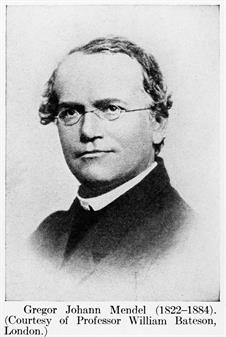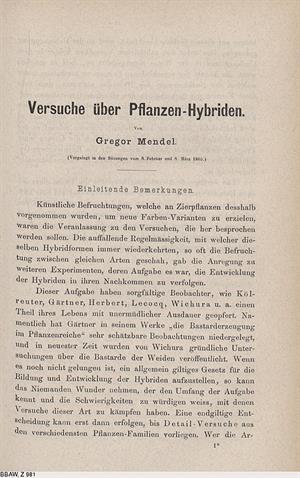
PUMPA - SMART LEARNING
எங்கள் ஆசிரியர்களுடன் 1-ஆன்-1 ஆலோசனை நேரத்தைப் பெறுங்கள். டாப்பர் ஆவதற்கு நாங்கள் பயிற்சி அளிப்போம்
Book Free Demo
Gregor Mendel
The early life of Mendel
Mendel was an Austrian monk who used his experiments to discover the basic principles of heredity. His research laid the groundwork for current genetics. In 1822, he was born into a peasant family in Silesian, Czechoslovakia. At the age of 18, he graduated from high school. He entered the Augustinian Monastery in Brunn in 1843. He was ordained as a priest in 1847.
He worked as a substitute teacher in mathematics and Greek after finishing his theological studies. He was sent to the University of Vienna for physics, mathematics, and natural science training in 1851. His failure did not diminish his zeal for the scientific search in the examinations for a teaching certificate.
Experimental life of Mendel
In 1854, Mendel returned to the monastery and continued to work as a priest and high school teacher. Mendel had a passion for gardening since he was a child.
He started his research with mice, then moved on to honeybees and plants before settling on garden peas as his primary model system.
A model system is an organism that allows a researcher to easily investigate a specific scientific question, such as how traits are inherited.
He started his famous experiments on the garden pea plant in his free time. From 1856 until 1865, he conducted his investigations in the monastery for nearly nine years. He had worked on approximately 10,000 pea plants of 34 types. They differ from one another in various ways. His papers were published in the proceedings of the Brunn Natural History Society in 1866 and 1867.

The first page of Gregor Mendel's original research paper
Many scientists had investigated the inheritance of features in peas and other species before Mendel. Still, he was the first to use his knowledge of science and mathematics to keep track of how many individuals in each generation exhibited a given trait, which aided him in formulating inheritance laws.
Rediscovery of Mendel’s principles
For 33 years, Mendel’s effort went unnoticed by the rest of the globe. Three botanists, Correns, De Vries, and Tshermark, rediscovered the concepts of genetics used by Mendel in 1990. Mendel’s unpublished works were exhumed from the grave and made available to the scientific community. He remained Abbot for the rest of his life. In 1884, he passed away. Mendel died before his work was recognised and appreciated.
Characteristics selected by Mendel
Pea plant
The pea plant has a lot of different characters. Mendel chose only seven characters from among these contrasting characters. There are two options for each of the even characters. The table below lists the seven characters and their opposing alternatives.

The seven characters and fourteen traits of Mendel's pea plants
S. No | Characteristics | Dominant | Recessive |
| 1. | The length of the stem | Tall | Dwarf |
| 2. | The position of the flower | Axial | Terminal |
| 3. | The colour of the pod | Green | Yellow |
| 4. | The shape of the pod | Inflated | Constricted |
| 5. | The shape of the seed | Round | Wrinkled |
| 6. | The colour of the flower | Violet | White |
| 7. | The colour of the cotyledon | Yellow | Green |
Reasons for Mendel's success:
Mendel studied the variations between different varieties of the garden pea Pisum sativum. Then he experimented with several varieties of pea plants to see what would happen if they were hybridised. Mendel's success was due to his wise selection of the traits of the plants. He chose the pea plant since it was beneficial for experimental work in a variety of ways.
The following are the reasons for the success of Mendel.
- Flowers of pea plants are naturally self-pollinated, so it is very easy to raise pure breeding individuals.
- The pea plant has several distinct contrasting characteristics.
- It is very easy to cultivate pea plants on open ground.
- The pea plant has a short life span as it was annual, and it was possible to follow several generations.
- The possibility of cross-pollination of a pea plant is easy.
- Hybrids of garden pea are perfectly fertile.
- Flowers are bisexual.
- Genes for the seven pairs of characteristics are located throughout seven homologous chromosomal pairs.
- Mendel maintained statistical records of the results of every experiment. It helped Mendel to derive numerical ratios of significance.
Important!
Note:
- Annual plants: Annual plants are those that have a one-year life cycle. Within a year, they germinate, grow, yield fruit, and die.
- Bisexual flowers: Flowers with both stamens and carpels are known as bisexual flowers. Male and female reproductive organs coexist in the same inflorescence. For example, lily, rose, and so on.
Reason for not recognised - Mendel experiment:
- Mendel's work was not published in an appropriate manner.
- Mendel interpreted the results using statistical techniques and mathematical logic. Most scientists at the time were unfamiliar with these techniques.
- As stated in the introduction, Mendel's stated that substances are responsible for the transmission of features as factors. This word is not precisely understood by the people who surrounded him.
A video explaining Mendel's laws of inheritance
Reference:
https://upload.wikimedia.org/wikipedia/commons/f/fc/Portrait_of_Gregor_Johann_Mendel%2C_Garrison._Wellcome_M0002351.jpg
https://upload.wikimedia.org/wikipedia/commons/e/ea/Mendel_seven_characters.svg
https://www.maxpixel.net/Green-Pod-Pea-Vegetables-Brown-Vegetables-Plant-2469490
https://upload.wikimedia.org/wikipedia/commons/thumb/c/c3/Mendel_paper.jpg/512px-Mendel_paper.jpg